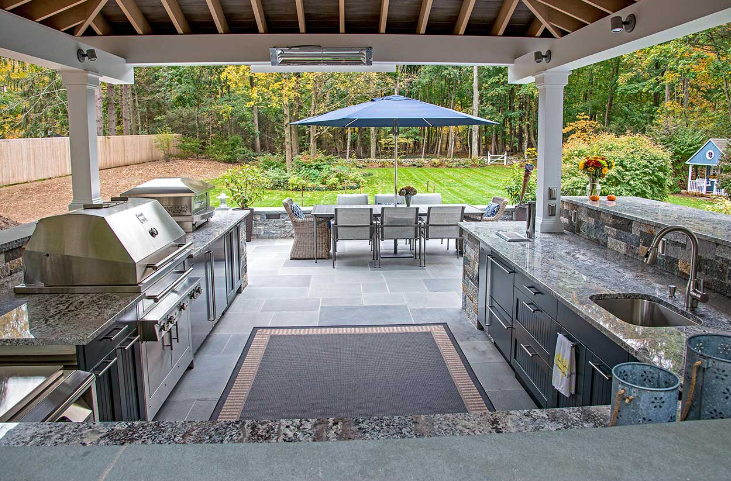An outdoor kitchen is a wonderful addition to any home. They are perfect for social gatherings, as they offer a way to cook and eat outside all year round while also providing an amazing focal point of your backyard. However, they can be quite costly and challenging to design and build. If you’re thinking about building an outdoor kitchen, here is what you need to know before jumping in. There are some special considerations when designing and building an outdoor kitchen. It’s not just a standard add-on feature that can be slapped on any house with a backyard. Outdoor kitchens have their own specific challenges with space and zoning regulations, as well as code requirements for exits, windows, sprinklers, and other building codes that don’t apply to standard cabinets or countertops. Here are some things you should know before getting started with your outdoor kitchen project.
Plan Your Kitchen Before You Build
If you want to build the perfect outdoor kitchen, you need to plan for it and design it with the perfect configuration and layout for your space. Then you can shop for materials and appliances with the exact measurements and specifications in mind, ensuring everything fits correctly in the space and looks great. Some questions you should ask yourself before designing your outdoor kitchen include: What is the purpose of your outdoor kitchen? How much space do you have? How many people will be using the kitchen at once? What appliances and features do you want in your outdoor kitchen? After deciding what kind of space you have and what you would like in your outdoor kitchen, you can start drawing up a floor plan, noting appliance and cabinet sizes and locations. This is the perfect way to visualize how your kitchen will look and save you from costly and time-consuming changes after the project is completed.
Kitchen Renovations in Kellyville: Transforming Your Space into a Stylish and Functional Haven
Outdoor Kitchen Codes and Regulations
Depending on your local zoning regulations, you may need a permit to build an outdoor kitchen. They are typically not as difficult to obtain as a regular building permit, but they do need to be approved. There are a few things you should look out for when researching regulations to ensure your outdoor kitchen is compliant. The dimensions of the structure and materials used must conform to the zoning minimums (typically 3 feet from the property line). You also don’t want to build something that blocks the fire exit or a nearby window. Kitchens are heavily regulated because they are spaces where dangerous stoves and other sources of heat and flames are used. The biggest challenge in building an outdoor kitchen is making sure it is compliant with the same codes as indoor kitchens. This means you need a proper way to vent exhaust from the stove and a way for smoke and gasses to escape the space safely, as well as an easy and safe way for people to exit the kitchen in an emergency.
Building Materials for Outdoor Kitchens
The materials you use to construct your outdoor kitchen are important and can make a big difference in how long it lasts. It’s best to choose durable materials with a high-quality finish that can withstand the elements. This means using low-maintenance materials like brick, stone, metal, and natural wood. They are more expensive but will last longer than synthetic materials like plastic, which can warp and damage in extreme conditions. There are also some special considerations when it comes to choosing the stoves and appliances in your kitchen. Cooktops should be made of cast iron or high-quality stainless steel. You should also select appliances with an automatic shut-off feature. These features will help prevent fires and make cleanup easier. Other safety features like beeping alarms and easy-to-read digital displays are also a good idea.
Staying Comfortable With Outdoor Kitchens
Kitchen materials like countertops, flooring, and cabinets can make a big difference in how well your kitchen stays clean and how comfortable you are working in it. The best materials to choose for your outdoor kitchen are low-maintenance, easy to clean, and as durable as you can get. Natural materials like wood and stone are ideal. You can also add features and elements like drop-down ceilings and cabinets that you can close off if your outdoor kitchen gets dirty or wet. This will extend the life of your kitchen and keep it looking nice longer. You can also add features like rubber flooring or a splash guard when working with messy foods like boiling pasta or watermelons.
Interesting information about wpc2021
Conclusion
An outdoor kitchen is a great addition to any home. They are perfect for social gatherings, as they offer a way to cook and eat outside all year round while also providing an amazing focal point of your backyard. However, they can be quite costly and challenging to design and build. If you’re thinking about building an outdoor kitchen, here is what you need to know before jumping in. There are some special considerations when designing and building an outdoor kitchen. It’s not just a standard add-on feature that can be slapped on any house with a backyard. Here are some things you should know before getting started with your outdoor kitchen project – Plan Your Kitchen Before You Build, Outdoor Kitchen Codes and Regulations, Building Materials for Outdoor Kitchens, and Staying Comfortable With Outdoor Kitchens.
Read also more information

